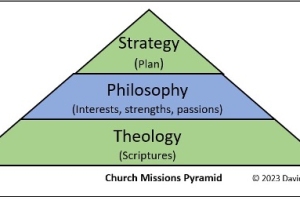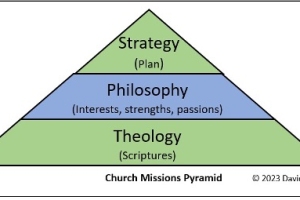Today, I want to talk about the pinnacle of the Global Missions Pyramid – strategy. For a local church to effectively fulfill its responsibilities in global missions, it must have clear strategic initiatives to guide its planning and decision-making.
 Strategy answers the question: What is God calling you to do in the world? Your strategy of missions should be consistent with your global missions theology and philosophy. Think of strategy as the adorned apex of your Global Missions Pyramid – what God is calling your church to do. This is the crowning adornment of your pyramid. You may change your strategy occasionally, but it should remain consistent with your theological foundation and philosophy. Your strategy defines how you will fulfill the biblical mandates within your philosophical framework. It represents what God is calling your church to do in the world. Strategy begins as a high-level view of what God wants you to do and, over time, narrows to specific initiatives to accomplish the strategy.
Strategy answers the question: What is God calling you to do in the world? Your strategy of missions should be consistent with your global missions theology and philosophy. Think of strategy as the adorned apex of your Global Missions Pyramid – what God is calling your church to do. This is the crowning adornment of your pyramid. You may change your strategy occasionally, but it should remain consistent with your theological foundation and philosophy. Your strategy defines how you will fulfill the biblical mandates within your philosophical framework. It represents what God is calling your church to do in the world. Strategy begins as a high-level view of what God wants you to do and, over time, narrows to specific initiatives to accomplish the strategy.
For example, your overall strategy may be to engage in and support planting and strengthening churches in the Middle East. This might result in more specific strategic initiatives like partnering with a church in a particular region engaged in church-panting, teaching church leaders, or sending your folks to encourage those on the frontlines of ministry there.
Strategy defines what you will do and how you will do it. Here is a five-step process to help you develop a philosophy of missions:
1. Prayer. Prayer. Prayer.
2. Research: Learn the knowledge, values, preferences, goals, and hopes of your constituents. Learn about missions opportunities.
3. Guiding Principles and Priorities: Decide on the primary biblical principles and values that will guide your missions ministry.
4. Mission: Craft a mission statement that will guide your decisions.
5. Strategy: Draft a strategy and get feedback and approvals. Your strategy can be as short as a paragraph but should be a page at maximum.
Strategy articulates specific goals and timelines for global missions. It identifies resources that will enable you to fulfill your philosophical desires and limit what you can do. This is the most flexible of the three levels of your Global Missions Pyramid.
I hope this series has been helpful. If you have questions, or need further direction on developing your church’s missions theology, philosophy, and strategy, MissioSERVE is here to serve you!

Taking Care of the Kids
Jun 28, 2024 2 min · Brian W To borrow from The Sound of Music: Has there ever been a problem like a missionary kid? Missionary kids fit into one of those problematic grey zones. They are not missionaries, but at the same time, they… Read More
Global Missions Philosophy
Sep 18, 2023 2 min · David S Today, I want to talk about the second level of the Global Missions Pyramid – philosophy. For a local church to effectively fulfill its responsibilities in global missions, she must understand who she… Read More
Global Missions Theology
Aug 14, 2023 2 min · David S For a local church to fulfill its responsibilities in global missions, it must understand God’s mandate, His character, and His interests before the church can develop an effective and long-lasting strategy.… Read MoreAuthor
Dr. Selvey is a global missions coach with Missioserve Alliance. He offers workshops and coaching opportunities to help churches be better missionary senders. He helps pastors and missions leadership develop and articulate their theology, philosophy, and strategy for global missions.